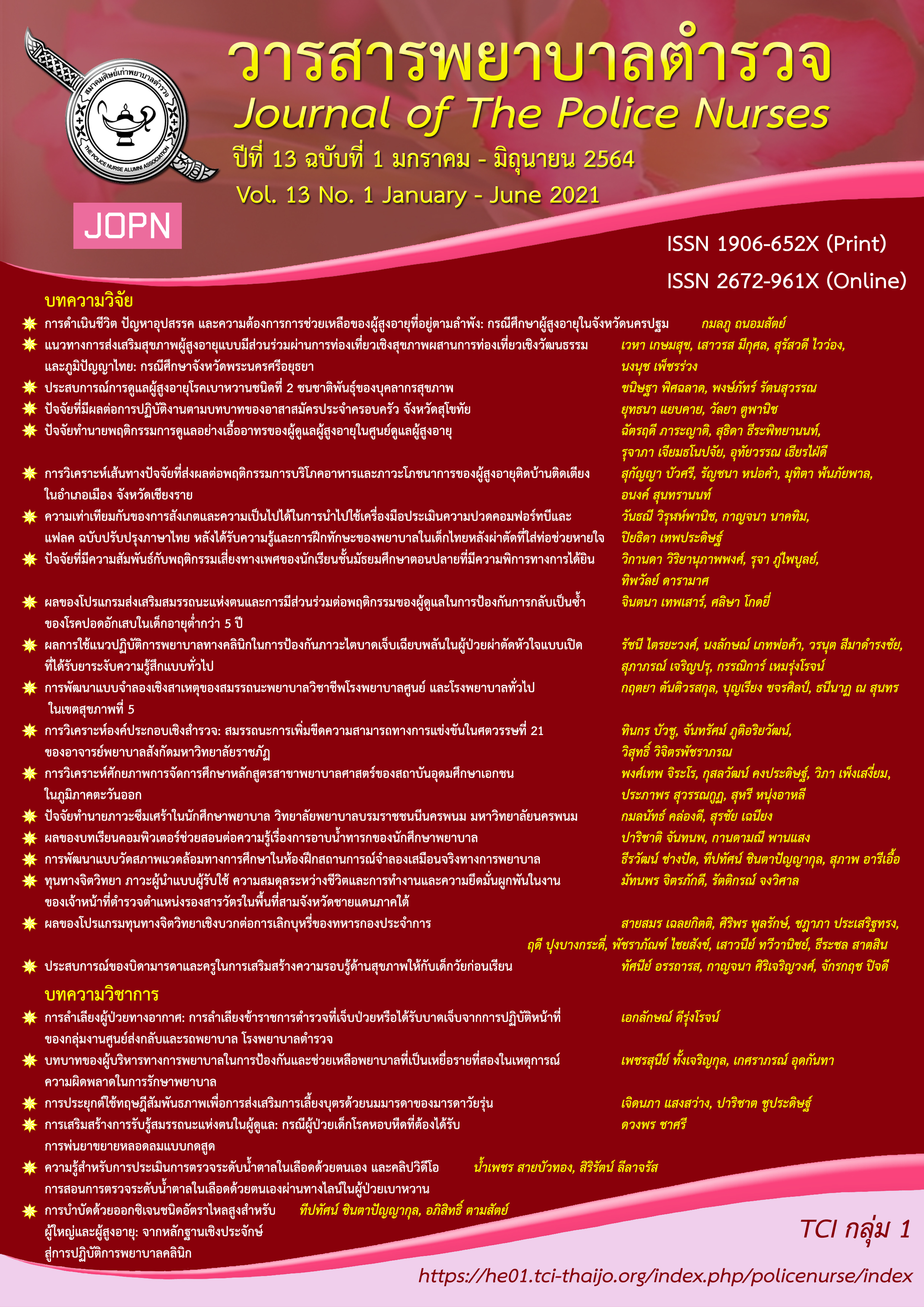การพัฒนาแบบจำลองเชิงสาเหตุของสมรรถนะพยาบาลวิชาชีพ โรงพยาบาลศูนย์ และโรงพยาบาลทั่วไปในเขตสุขภาพที่ 5
CAUSAL RELATIONSHIP MODEL OF FACTORS INFLUENCING ON PROFESSIONAL NURSES COMPETENCIES
คำสำคัญ:
การพัฒนาแบบจำลองเชิงสาเหตุ, พยาบาลวิชาชีพ, สมรรถนะบทคัดย่อ
งานวิจัยเชิงพรรณนาหาความสัมพันธ์นี้มีวัตถุประสงค์เพื่อ 1) พัฒนาแบบจำลองเชิงสาเหตุของปัจจัยที่ส่งผลต่อสมรรถนะพยาบาลวิชาชีพโรงพยาบาลศูนย์และโรงพยาบาลทั่วไป ในเขตสุขภาพที่ 5 2) ตรวจสอบความสอดคล้องของแบบจำลองเชิงสาเหตุกับข้อมูลเชิงประจักษ์ และ 3) ศึกษาขนาดของอิทธิพลทางตรง อิทธิพลทางอ้อม และอิทธิพลรวม ของปัจจัยเชิงสาเหตุที่ส่งผลต่อสมรรถนะพยาบาลวิชาชีพโรงพยาบาลศูนย์และโรงพยาบาลทั่วไปในเขตสุขภาพที่ 5 ตัวอย่าง คือ พยาบาลวิชาชีพ โรงพยาบาลศูนย์และโรงพยาบาลทั่วไป ในเขตสุขภาพที่ 5 จำนวน 577 คน ซึ่งได้มาโดยการสุ่มตัวอย่างแบบหลายขั้นตอน เครื่องมือที่ใช้ในการวิจัย คือ แบบวัดเกี่ยวกับภาวะผู้นำการเปลี่ยนแปลงของหัวหน้าหอผู้ป่วยตามการรับรู้ของพยาบาลวิชาชีพ บรรยากาศองค์การ ความผูกพันต่อองค์การ ความพึงพอใจในงาน และสมรรถนะพยาบาลวิชาชีพ ซึ่งมีค่าสัมประสิทธิ์แอลฟาของครอนบาค เท่ากับ .98, .94, .92, .93 และ .95 ตามลำดับ วิเคราะห์ข้อมูลโดยใช้การวิเคราะห์องค์ประกอบเชิงยืนยันในการตรวจสอบความตรงเชิงโครงสร้างของเครื่องมือวิจัย และการวิเคราะห์เส้นทางในการตอบวัตถุประสงค์วิจัย
ผลการวิจัยพบว่า 1) บรรยากาศองค์การ ความผูกพันต่อองค์การ ความพึงพอใจในงาน และภาวะผู้นำการเปลี่ยนแปลงตามการรับรู้ของพยาบาลวิชาชีพมีผลต่อสมรรถนะพยาบาลวิชาชีพ 2) แบบจำลองเชิงสาเหตุมีความสอดคล้องกลมกลืนกับข้อมูลเชิงประจักษ์ (chi-square = 101.80; df = 103; p = .515; GFI = .985; AGFI = .958; RMR = .007; RMSEA = .000) และ 3) ขนาดอิทธิพลของปัจจัยเชิงสาเหตุทั้งทางตรง ทางอ้อม และอิทธิพลรวม สามารถร่วมกันอธิบายความแปรปรวนของสมรรถนะพยาบาลวิชาชีพได้ร้อยละ 57 โดยบรรยากาศองค์การและความผูกพันต่อองค์การ มีอิทธิพลทางตรงเชิงบวกต่อสมรรถนะพยาบาลวิชาชีพ (DE = .28 และ .81) ภาวะผู้นำของหัวหน้าหอผู้ป่วยตามการรับรู้ของพยาบาลวิชาชีพมีอิทธิพลทางตรงเชิงลบต่อสมรรถนะพยาบาลวิชาชีพ (DE = -.13) ภาวะผู้นำการเปลี่ยนแปลงของหัวหน้าหอผู้ป่วยตามการรับรู้ของพยาบาลวิชาชีพที่ส่งผ่านความผูกพันต่อองค์การ มีอิทธิพลทางอ้อมเชิงบวกต่อสมรรถนะพยาบาลวิชาชีพ (IE = .04) และภาวะผู้นำการเปลี่ยนแปลงของหัวหน้าหอผู้ป่วยตามการรับรู้ของพยาบาลวิชาชีพที่ส่งผ่านความพึงพอใจในงานและความผูกพันต่อองค์การ มีอิทธิพลทางอ้อมเชิงบวกต่อสมรรถนะพยาบาลวิชาชีพ (IE = .03) บรรยากาศองค์การ ที่ส่งผ่านความผูกพันต่อองค์การ มีอิทธิพลทางอ้อมเชิงบวกต่อสมรรถนะพยาบาลวิชาชีพ (IE = .04) และบรรยากาศองค์การ ที่ส่งผ่านความพึงพอใจในงาน และความผูกพันต่อองค์การ มีอิทธิพลทางอ้อมเชิงบวกต่อสมรรถนะพยาบาลวิชาชีพ (IE = .62 และ 3.3) นอกจากนี้ ตัวแปรที่มีขนาดอิทธิพลรวมเชิงบวกสูงสุด คือ บรรยากาศองค์การ (TE = .84) รองลงมา คือ ความผูกพันต่อองค์การ (TE = .81) สำหรับภาวะผู้นำการเปลี่ยนแปลงของหัวหน้าหอผู้ป่วยตามการรับรู้ของพยาบาลวิชาชีพ มีขนาดอิทธิพลรวมเชิงลบ (TE = -.12)
Downloads
เอกสารอ้างอิง
Allen, N. J., & Meyer, J. P. (1990). The measurement and antecedents of affective, continuance, And normative commitment to the organization. Journal Of Occupational Psychology, 63(10), 1-18.
Avolio, B. J., & Bass, B. M. (1995). Improving organization effectiveness though transformational leadership. Thausand Osks: Sage.
Benner, P. (1984). Form novice to expert: Excellence and power in clinical nursing practice. California, CA: Addison-Wesley.
Berton, J. P., Thomas, W. L., & Brooks, C. H. (2002). The influences of motivation to attend ability to attend, and organizational commitment on different type of absence behavior. Journal of Managerial, 14(2), 233-248.
Brown, W. B., & Mogerg. D. J. (1980). Organization theory and Management: A macro approach. New York, NY: Joho Wiley and Sons.
Dunham, J., & Klafehn, K. A. (1990). Transformation leadership and the nurse executive. Journal of Nursing Administration, 20(4), 28-34.
George, J. M., & Jones, G. R. (1999). Understanding and managing organizational behavior (3rd ed.). New Jersey, NJ: Prentice-Hall.
Gibson, J. L., Invancevich J. M., & Dornelly, H. (2000). Organization: Behavior, structure, processes (10th ed.). Boston: McGraw-Hill.
Hair, J. F., Black, W. C., Babin, B. J., Anderson, R. E., & Tatham, R. L. (2006). Multivariate data analysis (6th ed.). Upper Saddle River, New Jersey, NJ: Prentice-Hall.
Hanucharoenkul, S. (2000). Nursing: The science of practice. Bangkok: V.J. printing.
Jamsawang, B. (2009) Relationships between personal factors, organizational commitment, and emergency nursing competencies among professional nurses in private hospitals, Pathumthani (The Master of Science, Nursing administration). Eastern Asia University, Pathum Thani.
Kaewkongpan, C. (2014). Factors related to the competency of nurses in Tambol Health Promoting Hospitals, the Upper North Eastern Part (The Master of Nursing Science, Nursing Administration). Sukhothai Thammathirat University, Nonthaburi.
Kanlong, S. (2012). Quality inspection of research tools. Retrieved from http://www.ipernity.com/blog/252172/477413
Karami, A., Farokhzadian, J., & Foroughameri, G. (2017). Nurses’ professional competency and organizational commitment: Is it important for human resource management? PloS one, 12(11), e0187863.
Litwin, G., & Stringer, R. (2002). Leadership and organization climate. Upper Saddle River, New Jersey, NJ: Prentice-Hall.
McClelland, D. C. (1973). Testing for competence rather than for intelligence. American psychologist, 28(1), 1.
Muangmun, P. (2008). Factors affecting competency in professional nurses as perceived by professional nurses in general hospital eastern region (The Master of Science, Nursing administration). Burapha University, Chonburi.
Spector, P. E. (1997). Industrial and organizational psychology (2nd ed.). New York, NY: John Wiley & Sons.
Stringer, R. (2002). Leadership and organization climate. New Jersey, NJ: McGraw – Hill.
Thailand Nursing and Midwifery Council. (2018). Notification of nursing council subject: Core competencies of bachelor’s, master’s, doctoral degree graduates. Source: Retrieved form https://www.tnmc.or.th/images/userfiles/files/004.pdf
ดาวน์โหลด
รูปแบบการอ้างอิง
ฉบับ
ประเภทบทความ
สัญญาอนุญาต
ผลงานที่ได้ตีพิมพ์แล้วจะเป็นลิขสิทธิ์ของวารสารพยาบาลตำรวจ















